Venezuela-Round Two
Ken Neill
published in The Fisherman
 Last year I had the opportunity to go to Venezuela and fish as part of a study of white marlin. Dr. John Graves of the Virginia Institute of Marine Science needed an angler to help him catch fish so that he could attach pop-up satellite tags to them. Dr. Guy Harvey also fished with us while filming his television series. It was a fantastic trip and I considered it a once-in-a-lifetime opportunity. Well, once-in-a-lifetime turned into twice-in-a-lifetime when I was asked to go again later this fall. That trip is coming up and I am really looking forward to it, more marlin research and fishing with Guy Harvey.
Last year I had the opportunity to go to Venezuela and fish as part of a study of white marlin. Dr. John Graves of the Virginia Institute of Marine Science needed an angler to help him catch fish so that he could attach pop-up satellite tags to them. Dr. Guy Harvey also fished with us while filming his television series. It was a fantastic trip and I considered it a once-in-a-lifetime opportunity. Well, once-in-a-lifetime turned into twice-in-a-lifetime when I was asked to go again later this fall. That trip is coming up and I am really looking forward to it, more marlin research and fishing with Guy Harvey.
 Dr. Graves received reports that the fishing was very good in Venezuela right now. He booked an earlier trip so that he could get more tags out. This trip was supposed to consist of Dr. Graves and one of his graduate students. The student could not make the trip so once again, I was asked if I could go. Let me tell you, it is a good thing to be adopted as a research assistant by a scientist studying billfish. After making sure that my father was available to take care of my patients and gaining permission for yet another trip from my wife, I was off to Venezuela for four days of fishing.
Dr. Graves received reports that the fishing was very good in Venezuela right now. He booked an earlier trip so that he could get more tags out. This trip was supposed to consist of Dr. Graves and one of his graduate students. The student could not make the trip so once again, I was asked if I could go. Let me tell you, it is a good thing to be adopted as a research assistant by a scientist studying billfish. After making sure that my father was available to take care of my patients and gaining permission for yet another trip from my wife, I was off to Venezuela for four days of fishing.
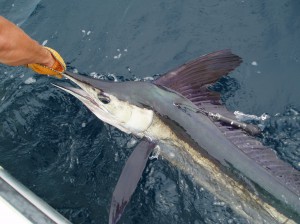 The trip down was a bit of an adventure. Last year, the tags caused a bit of a stir at the security station in the airport. They had to check them out with special bomb sniffing equipment before we could carry them onto the plane. This year, the tags went through without a problem. The lady in front of us, who was trying to bring on a small cooler of breast milk had a problem though. Our flight to Atlanta was delayed due to construction at the Atlanta airport. We finally got to Atlanta right after our flight to Venezuela had left. There were no other flights so we got to spend the night in Atlanta. The next flight out was not until the next evening, we had a day to burn. Our four days of fishing had now been reduced to three days. We visited the Atlanta Aquarium. It is a bit different visiting an aquarium with a marine scientist. I had my own personal tour guide. The aquarium was nice but I was ready to catch something.
The trip down was a bit of an adventure. Last year, the tags caused a bit of a stir at the security station in the airport. They had to check them out with special bomb sniffing equipment before we could carry them onto the plane. This year, the tags went through without a problem. The lady in front of us, who was trying to bring on a small cooler of breast milk had a problem though. Our flight to Atlanta was delayed due to construction at the Atlanta airport. We finally got to Atlanta right after our flight to Venezuela had left. There were no other flights so we got to spend the night in Atlanta. The next flight out was not until the next evening, we had a day to burn. Our four days of fishing had now been reduced to three days. We visited the Atlanta Aquarium. It is a bit different visiting an aquarium with a marine scientist. I had my own personal tour guide. The aquarium was nice but I was ready to catch something.
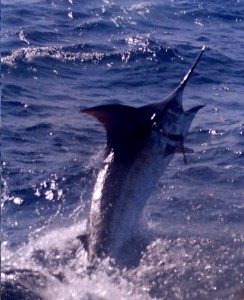 When we finally arrived in Venezuela, we were met at the airport by the manager of our destination, Mango Marina. After a short drive from the airport, we were finally at one of the best fishing destinations in the world. We had a goodnight’s sleep and a great breakfast and then we were finally off to catch some fish.
When we finally arrived in Venezuela, we were met at the airport by the manager of our destination, Mango Marina. After a short drive from the airport, we were finally at one of the best fishing destinations in the world. We had a goodnight’s sleep and a great breakfast and then we were finally off to catch some fish.
 We had the pleasure of fishing with Capt. Bubba Carter. Capt. Carter is one of those guys who you see on ESPN and in the national fishing magazines. He has fished all over the world and has now settled in Venezuela as the place to be to catch billfish, lots of billfish. I knew of his reputation and I met him when we were down there last fall but this was my first chance to fish with him. His reputation is well deserved. Besides being a great captain, he is a great teacher. With his instruction and with the many shots at marlin that you get in a day there, I learned more in the few days than I have while trying it on my own for years.
We had the pleasure of fishing with Capt. Bubba Carter. Capt. Carter is one of those guys who you see on ESPN and in the national fishing magazines. He has fished all over the world and has now settled in Venezuela as the place to be to catch billfish, lots of billfish. I knew of his reputation and I met him when we were down there last fall but this was my first chance to fish with him. His reputation is well deserved. Besides being a great captain, he is a great teacher. With his instruction and with the many shots at marlin that you get in a day there, I learned more in the few days than I have while trying it on my own for years.
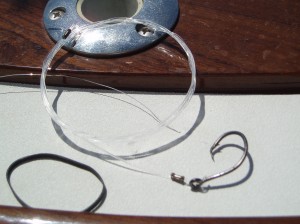 Dr. Graves study concerns catching white marlin on circle hooks. He has studied the survivability of released white marlin caught on J-hooks compared to circle hooks. The circle hook caught fish had a much greater survival rate which is why we will likely be required to use circle hooks during marlin tournaments next year. Not all circle hooks are made the same however. There are three basic styles: the classic circle, a circle with an offset, and a circle that is basically a J-hook with the point bent in. The proposed regulations will require us to use non-offset circle hooks next year but there is very little science supporting that. This part of Dr. Graves study is looking at the survivability of white marlin caught on the various styles of circle hooks. He is also looking at hook placement with the various hooks. He is starting to look at retention with different hook types. How many fish get off after they are hooked?
Dr. Graves study concerns catching white marlin on circle hooks. He has studied the survivability of released white marlin caught on J-hooks compared to circle hooks. The circle hook caught fish had a much greater survival rate which is why we will likely be required to use circle hooks during marlin tournaments next year. Not all circle hooks are made the same however. There are three basic styles: the classic circle, a circle with an offset, and a circle that is basically a J-hook with the point bent in. The proposed regulations will require us to use non-offset circle hooks next year but there is very little science supporting that. This part of Dr. Graves study is looking at the survivability of white marlin caught on the various styles of circle hooks. He is also looking at hook placement with the various hooks. He is starting to look at retention with different hook types. How many fish get off after they are hooked?
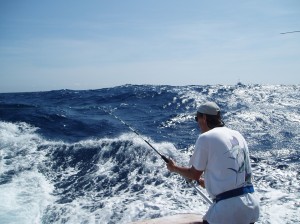 Fishing off of Venezuela is just ridiculous. They have good numbers of sailfish but the captains don’t really target them, the marlin fishing is just too good. If they need a sail for some slam, they may move in shallower to target them but in general, they catch plenty of sails while marlin fishing. Grand slams are so common that nobody even raises an eyebrow when you get one. There are enough blue marlin around that with all of the white marlin and sailfish, double, triple and even higher order of slams are not uncommon. The three days we were there, the top blue marlin boat had 5 blue marlin releases. They did not have enough whites to make a quintuple slam though. At least one double slam was registered each day we were there. Besides the marlin and sailfish, Venezuela is one of the best places in the world to catch a swordfish. They don’t have to drift for them all night like we do on the East Coast. They drop for them in the middle of the day. When grand slams become commonplace, you can drop for a super slam to make things more of a challenge. It does not stop there though. There are also a good number of spearfish caught. A half dozen or so were caught during the three days that we were there. Five billfish species in a single day, Venezuela is the place to make a fantasy slam happen. Good fishing can be had all year. The white marlin that we are after tend to be most concentrated September through November. During this time, double digit catches are common.
Fishing off of Venezuela is just ridiculous. They have good numbers of sailfish but the captains don’t really target them, the marlin fishing is just too good. If they need a sail for some slam, they may move in shallower to target them but in general, they catch plenty of sails while marlin fishing. Grand slams are so common that nobody even raises an eyebrow when you get one. There are enough blue marlin around that with all of the white marlin and sailfish, double, triple and even higher order of slams are not uncommon. The three days we were there, the top blue marlin boat had 5 blue marlin releases. They did not have enough whites to make a quintuple slam though. At least one double slam was registered each day we were there. Besides the marlin and sailfish, Venezuela is one of the best places in the world to catch a swordfish. They don’t have to drift for them all night like we do on the East Coast. They drop for them in the middle of the day. When grand slams become commonplace, you can drop for a super slam to make things more of a challenge. It does not stop there though. There are also a good number of spearfish caught. A half dozen or so were caught during the three days that we were there. Five billfish species in a single day, Venezuela is the place to make a fantasy slam happen. Good fishing can be had all year. The white marlin that we are after tend to be most concentrated September through November. During this time, double digit catches are common.
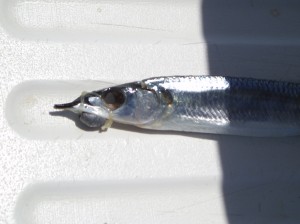 Well what did we learn? I am learning how to catch a marlin on a circle hook. I had to agree to that before they would take me. It is hard to measure hook-up rates, what is a bite? Personally, I seem to be able to hook white marlin equally well (or equally bad) with circle hooks or J-hooks. After three days of fishing with Bubba Carter, I’m getting better with circle hooks and I suspect my hook up rate with them will be better than I was getting with J-hooks. I expect also that what I learned from Capt. Carter will help my J hook-up ratio so it is probably a wash. Dr. Graves’ studies are on-going and there is a lot of data to be gathered. I can offer some early observations. If you want your marlin to have the best chance of survival after release, you should be using circle hooks. The style of circle does not seem to matter a bit as to hook placement. All three styles hook in the corner of the mouth almost all of the time. There may be a problem with the offset circle however. This summer, I was using the offset circle off of Virginia as part of this study. We hooked six white marlin with these hooks and caught all six. Each one was hooked in the corner of the jaw. I just tied my leader directly to the eye of the hook. In Venezuela, we had the leader crimped to the hook after passing it through the eye, around the shank and back out. This is done, in theory, to help the rotation of the circle hook. We defined a hook-up as a fish that was hooked for at least 30 seconds and we timed it. Twenty seconds of running and jumping did not count. We just picked a standard time, sometimes these fish will jump and pull drag while just holding onto the bait. After 30 seconds, we thought most fish would really be hooked. With the regular circles we lost one fish after hook-up when the shank of the hook broke. No hooks pulled. With the circles that are shaped like a J-hook with the point turned in, no fish were lost after hook-up. With the offset circles, we had the hook pull on eight fish after hook-up. The fish that we caught were hooked in the corner of the mouth but a couple of them were bleeding. It is possible that the offset circles are grabbing deeper in the fish and then pulling. Some would re-hook in the corner of the jaw while others would pull on out and result in a lost fish. It will be interesting to see if the survival rate is lower for the offset circles. Right now, I would choose a non-offset circle to fish with. There are a number of ways to rig a ballyhoo on a circle hook as a skip bait. To get them to swim typically involves using a swivel attached to the top of the ballyhoo head and running the hook through the ring of the swivel or by using a loop in rigging wire in place of the swivel. A problem with the swivel method is that you have to have the exact right size swivel for your hook. If it is too big, the hook can come out during your drop back. A problem with using a loop in rigging wire is that eventually the wire will fatigue and break, typically at the worst possible time. We fished with them rigged all different ways in Venezuela. One way that I really liked was with a small chin weight attached to the ballyhoo with waxed rigging floss. This made a harness in front of the eyes that any size or style of hook could be slipped behind. It swam well, the floss never broke, and we never had a ballyhoo fall off during drop back.
Well what did we learn? I am learning how to catch a marlin on a circle hook. I had to agree to that before they would take me. It is hard to measure hook-up rates, what is a bite? Personally, I seem to be able to hook white marlin equally well (or equally bad) with circle hooks or J-hooks. After three days of fishing with Bubba Carter, I’m getting better with circle hooks and I suspect my hook up rate with them will be better than I was getting with J-hooks. I expect also that what I learned from Capt. Carter will help my J hook-up ratio so it is probably a wash. Dr. Graves’ studies are on-going and there is a lot of data to be gathered. I can offer some early observations. If you want your marlin to have the best chance of survival after release, you should be using circle hooks. The style of circle does not seem to matter a bit as to hook placement. All three styles hook in the corner of the mouth almost all of the time. There may be a problem with the offset circle however. This summer, I was using the offset circle off of Virginia as part of this study. We hooked six white marlin with these hooks and caught all six. Each one was hooked in the corner of the jaw. I just tied my leader directly to the eye of the hook. In Venezuela, we had the leader crimped to the hook after passing it through the eye, around the shank and back out. This is done, in theory, to help the rotation of the circle hook. We defined a hook-up as a fish that was hooked for at least 30 seconds and we timed it. Twenty seconds of running and jumping did not count. We just picked a standard time, sometimes these fish will jump and pull drag while just holding onto the bait. After 30 seconds, we thought most fish would really be hooked. With the regular circles we lost one fish after hook-up when the shank of the hook broke. No hooks pulled. With the circles that are shaped like a J-hook with the point turned in, no fish were lost after hook-up. With the offset circles, we had the hook pull on eight fish after hook-up. The fish that we caught were hooked in the corner of the mouth but a couple of them were bleeding. It is possible that the offset circles are grabbing deeper in the fish and then pulling. Some would re-hook in the corner of the jaw while others would pull on out and result in a lost fish. It will be interesting to see if the survival rate is lower for the offset circles. Right now, I would choose a non-offset circle to fish with. There are a number of ways to rig a ballyhoo on a circle hook as a skip bait. To get them to swim typically involves using a swivel attached to the top of the ballyhoo head and running the hook through the ring of the swivel or by using a loop in rigging wire in place of the swivel. A problem with the swivel method is that you have to have the exact right size swivel for your hook. If it is too big, the hook can come out during your drop back. A problem with using a loop in rigging wire is that eventually the wire will fatigue and break, typically at the worst possible time. We fished with them rigged all different ways in Venezuela. One way that I really liked was with a small chin weight attached to the ballyhoo with waxed rigging floss. This made a harness in front of the eyes that any size or style of hook could be slipped behind. It swam well, the floss never broke, and we never had a ballyhoo fall off during drop back.
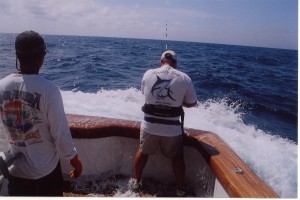 It was hard leaving that tremendous marlin bite but it was a lot easier knowing that in a month I will be back down there fishing with Dr. John Graves, Dr. Guy Harvey, Capt. Bubba Carter, and Capt. Jimmy Grant (another of those captains on television and in all the magazines). If you would like to experience this fishery for yourself, it is a four hour flight from Atlanta or a three hour flight form Miami. Capt Carter can be reached at: [email protected] . Capt. Jimmy Grant can be reached at: [email protected] . Dr. John Graves can be reached at: [email protected] .
It was hard leaving that tremendous marlin bite but it was a lot easier knowing that in a month I will be back down there fishing with Dr. John Graves, Dr. Guy Harvey, Capt. Bubba Carter, and Capt. Jimmy Grant (another of those captains on television and in all the magazines). If you would like to experience this fishery for yourself, it is a four hour flight from Atlanta or a three hour flight form Miami. Capt Carter can be reached at: [email protected] . Capt. Jimmy Grant can be reached at: [email protected] . Dr. John Graves can be reached at: [email protected] .
